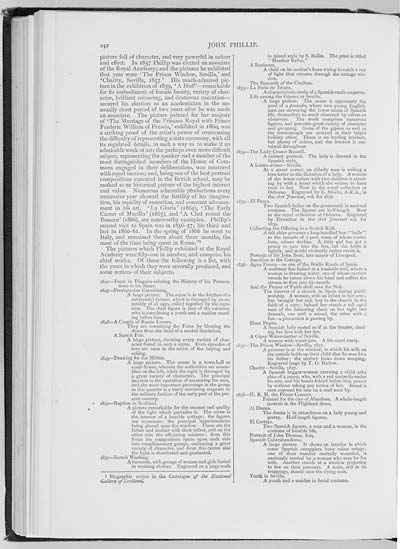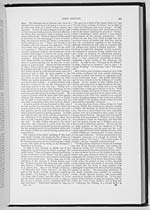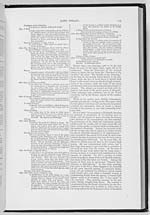242
picture full of character, and very powerful in colour
and effect. In 1857 Phillip was elected an associate
of the Royal Academy; and the pictures he exhibited
that year were 'The Prison Window, Sevilla,' and
'Charity, Sevilla, 1857.' His much-admired pic-
ture in the exhibition of 1859, 'A Huff"'�remarkable
for its embodiment of female beauty, variety of char-
acter, brilliant colouring, and dexterous execution�
secured his election as an academician in the un-
usually short period of two years after he was made
an associate. The picture painted for her majesty
of 'The Marriage of the Princess Royal with Prince
Frederic William of Prussia,' exhibited in 1860, was
a striking proof of the artist's power of overcoming
the difficulty of representing a state ceremony, with all
its regulated details, in such a way as to make it an
admirable work of art; the perhaps even more difficult
subject, representing the speaker and a number of the
most distinguished members of the House of Com-
mons engaged in their deliberations, was mastered
with equal success; and, being one of the best portrait
compositions executed in the British school, may be
ranked as an historical picture of the highest interest
and value. Numerous admirable productions every
successive year showed the fertility of his imagina-
tion, his rapidity of execution, and constant advance-
ment in his art. 'La Gloria' (1864), 'The Early
Career of Murillo' (1865), and 'A Chat round the
Brasero' (1866), are noteworthy examples. Phillip's
second visit to Spain was in 1856-57; his third and
last in 1860-61. In the spring of 1866 he went to
Italy, and remained there about three months, the
most of the time being spent in Rome."1
The pictures which Phillip exhibited at the Royal
Academy were fifty-one in number, and comprise his
chief works. Of these the following is a list, with
the years in which they were severally produced, and
some notices of their subjects.
1840�Tasso in Disguise relating the History of his Persecu-
tions to his Sister.
1847�Presbyterian Catechising,
A large picture. The scene is in the kitchen of a
substantial farmer, which is thronged by an as-
sembly of all ages, called together by the pqca-
sion. The chief figure is that of the minister,
who is catechising a youth and a maiden stand-
ing before him.
1848�A Couple of Rustic Lovers.
They are consulting the Fates by blowing the
down from the head of a seeded dandelion.
A Scotch Fair.
A large picture, showing every variety of char-
acter found in such a scene. Even episodes of
love are seen in the midst of the buying and
selling.
1849�Drawing for the Militia.
A large picture. The scene is a town-hall or
court-house, wherein the authorities are assem-
bled on the left, while the right is thronged by
a great variety of characters. The principal
incident is the operation of measuring the men,
and the most important personage in the group
in this quarter is a burly recruiting sergeant in
the military fashion of the early part of the pre-
sent century.
1850 -Baptism in Scotland.
A picture remarkable for the amount and quality
of the light which pervades it. The scene is
the interior of a humble cottage; the figures
are numerous; the principal impersonations
being placed near the. window. These are the
father and mother with their infant, and on the
other side the officiating minister; from this
focus the composition opens upon each side
into complimentary groups, embracing a great
variety of character, and from this centre also
the light is distributed and graduated.
1851�Scotch Washing.
A burnside, with groups of women and girls busied
in washing clothes. Engraved on a large scale
1 Biographic notice in the Catalogue of the National
Gallery of Scotland,
in mixed style by S. Bellin. The print is titled
"Heather Belles."
A Sunbeam.
A child on its mother's knee trying to catch a ray
of light that streams through the cottage win-
dow.
The Spaewife of the Clachan.
1853�La Perla de Triana.
A characteristic study of a Spanish rustic coquette.
Life among the Gipsies at Seville.
A large picture. The scene is apparently the
yard of a possada, where two young English-
men are surveying the lower strata of Spanish
life, themselves as much observed by others as
observers. The work comprises numerous
figures, and presents great variety of character
and grouping. Some of the gipsies as well as
the townspeople are arrayed in their bright
holiday attire. There is no leading incident,
but plenty of action, and the interest is sus-
tained throughout.
1854�The Lady Cosmo Russell.
A cabinet portrait. The lady is dressed in the
Spanish style.
A Letter-writer�Seville.
At a street corner, an elderly man is writing a
love-letter to the dictation of a lady. A woman
of the lower orders with two children is stand-
ing by with a letter which she wishes to have
read to her. Now in the royal collection at
Osborne. Engraved by L. Stocks, A.R.A., in
the Art Journal, vol. for 1858.
1855�El Paseo.
Two Spanish ladies on the promenade in national
costume. The figures are half-length. Now
in the royal collection at Osborne. Engraved
by Devachez in the Art Journal vol. for
1850.
Collecting the Offering in a Scotch Kirk.
A tall elder presents a long-handled box ("ladle")
to the tenants of a pew, some of whom contri-
bute, others decline. A little girl has got a
penny to pass into the box, but she holds it
tightly, and would evidently rather retain it.
Portrait of Sir John Bent, late mayor of Liverpool.
Sunshine in the Cottage.
1856- -Agua Fresca�on one of the Bridle Roads of Spain.
A muleteer has halted at a roadside well, where a
woman is drawing water, one of whose earthen
vessels he raises above his head and suffers the
stream to flow into his mouth.
And the Prayer of Faith shall save the Sick.
The interior of a church in Spain during public
worship. A woman, with an infant in her arms,
has brought her sick boy to the church in the
faith of a cure; behind her stands a tall aged
man of the labouring class; on her right two
damsels, one with a missal, the other with a
fan�a procession is passing by.
Dona Pepita.
A Spanish lady seated as if at the theatre, shad-
ing her face with her fan.
A Gipsy Water-carrier of Seville.
A woman with water-jars. A life-sized study.
1857�The Prison Window�Sevilla, 1857.
A prisoner is at the window, to which his wife on
the outside holds up their child that he may kiss
his father; the mother looks down weeping.
Engraved large by T. O. Barlow.
Charity�Sevilla, 1857.
A Spanish beggar-woman carrying a child asks
alms of a priest, who, with a red umbrella under
his arm, and his hands folded before him, passes
by without taking any notice of her. Bread is
seen exposed for sale on a stall near by.
1858�H. R. H. the Prince Consort.
Painted for the city of Aberdeen. A whole-length
portrait in the Highland dress.
Al Duena.
The duena is in attendance on a lady young and
pretty. Half-length figures.
El Cortejo.
Two Spanish figures, a man and a woman, in the
costume of humble life.
Portrait of John Thomas, Esq.
Spanish Contrabandistas.
A large picture. It shows an interior in which
some Spanish smugglers have taken refuge;
one of their number mortally wounded, is
anxiously tended by a woman who may be his
wife. Another stands at a window preparing
to fire on their pursuers. A mule, still in its
trappings, stands near the dying man.
Youth in Seville.
A youth and a maiden in festal costume.

![]() Universal Viewer |
Universal Viewer | ![]() Mirador |
Large image | Transcription
Mirador |
Large image | Transcription
![]()

